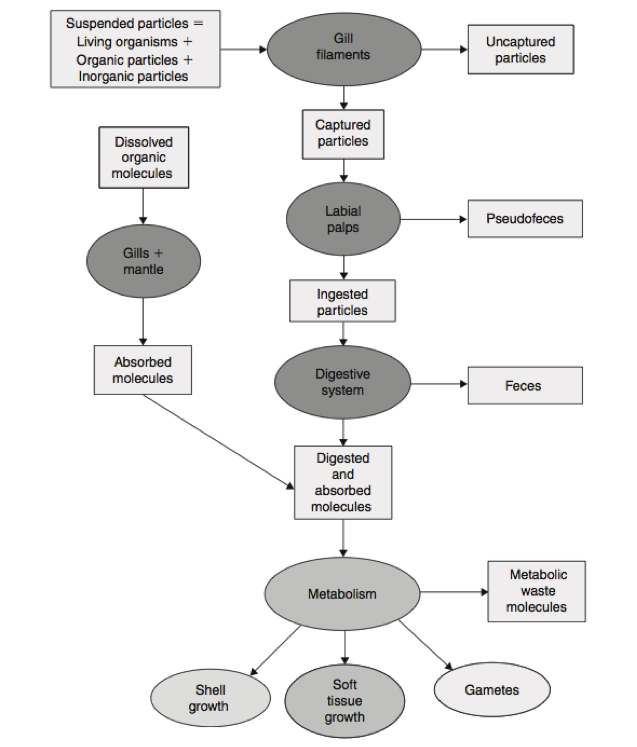Feeding
Pinctada margaritifera inhabits the obligotrophic waters of atolls and coral reefs where primary productivity may be low. The basic processes of feeding are similar to other filter-feeding bivalves. Pearl oysters filter feed on suspended particulate matter, consisting mainly of bacteria, micro-algae, suspended organic matter and inorganic particles. Particle size, density, composition and digestibility affect the nutritional value. Pinctada margaritifera is also reported to feed upon a variety of living and dead organic particles, including large amounts of mud, bivalve eggs and larvae and suggests nonselective feeding in the species (Nasr 1984). This inefficient feeding may also explain the omission of Pinctada margaritifera from the turbid waters of some closed lagoons in Polynesia.
Water currents are very important in bringing food and oxygen to pearl oysters and carrying away their wastes. Strong currents however, may be harmful by increasing the amount of suspended inorganic matter to a level that interferes with filtering.
There are often significant amounts of dissolved organic matter in seawater and this is another potential source of nutrients for pearl oysters, although there are no data for this. The large surfaces of exposed epithelium within their mantle cavity and water currents through it facilitate exchanges of inorganic and organic molecules between the soft tissues and the surrounding water.

Pallial organ
The pallial organ, consisting of gills and labial palps, is responsible for capture and sorting of food particles before ingestion. Feeding and respiration happen as currents of water flow into the anterior and ventral regions of the mantle cavity, and through the eulamellibranch gill filaments. Water currents through the gill filaments are maintained by beating of lateral cilia on the inter-filament spaces and some suspended particular matter is collected by these cilia. Trapped particles are bound in a mucous layer of frontal cilia on the gill filaments and moved by these cilia to ventral food grooves on the filaments. The particles and mucus are formed into mucous strings in these ciliated ventral food grooves and passed to labial palps at the mouth. The opposing palp lamellae fluidize the mucus to release the bound particles. Particles are then ingested as a mucous slurry (Ward and Shumway 2004). The mechanism of particle sorting by the labial palps is not well understood but it is believed that , material that is not ingested due to size or nutritional value, is released from the palps in mucus-bound bundles as pseudofeces. Pseudofeces are also formed at the food groove and labial palp junction when the rate of particle capture exceeds the processing capacity of the labial palps or the ingestion rate. These pseudofeces are carried to the posterior of the mantle cavity and pass gently out of the mantle cavity in the vicinity of the excurrent region. The feces, which are ribbons of compact pellets, are collected by excurrents and released through the anus.
There are several features of the gills of Pinctada margaritifera that affect their functioning. Firstly, the gill size and surface area is relatively very large. Secondly, the gill microstructure is notable for not having laterofrontal cirri on the gill filaments which are used to assist the frontal and lateral cilia in their function of capturing suspended particles (Pouvreau et al. 1999). |